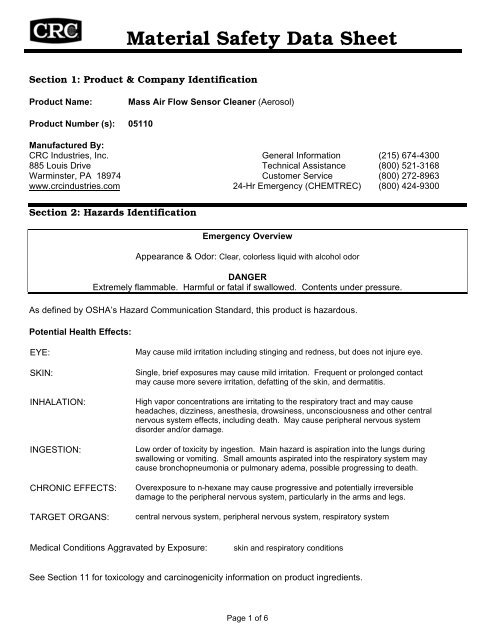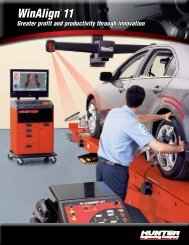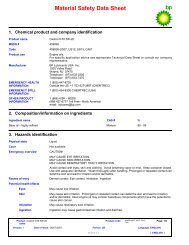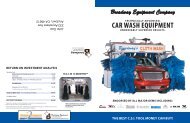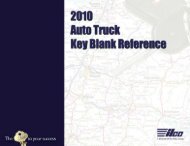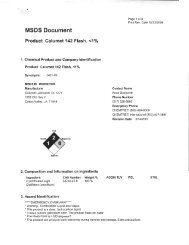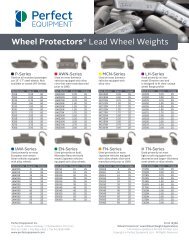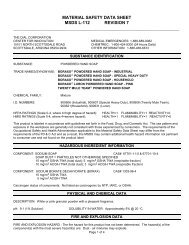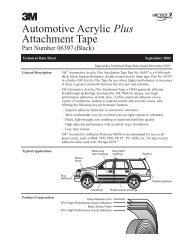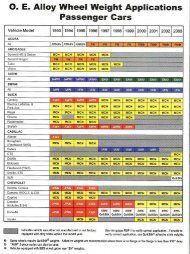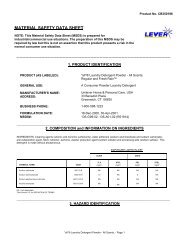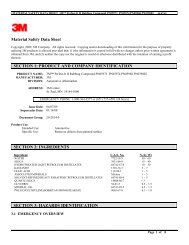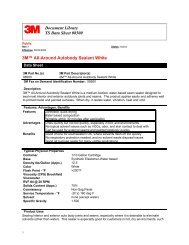Mass Air Flow Sensor Cleaner
Mass Air Flow Sensor Cleaner
Mass Air Flow Sensor Cleaner
- No tags were found...
You also want an ePaper? Increase the reach of your titles
YUMPU automatically turns print PDFs into web optimized ePapers that Google loves.
Material Safety Data SheetSection 1: Product & Company IdentificationProduct Name:<strong>Mass</strong> <strong>Air</strong> <strong>Flow</strong> <strong>Sensor</strong> <strong>Cleaner</strong> (Aerosol)Product Number (s): 05110Manufactured By:CRC Industries, Inc. General Information (215) 674-4300885 Louis Drive Technical Assistance (800) 521-3168Warminster, PA 18974 Customer Service (800) 272-8963www.crcindustries.com 24-Hr Emergency (CHEMTREC) (800) 424-9300Section 2: Hazards IdentificationEmergency OverviewAppearance & Odor: Clear, colorless liquid with alcohol odorDANGERExtremely flammable. Harmful or fatal if swallowed. Contents under pressure.As defined by OSHA’s Hazard Communication Standard, this product is hazardous.Potential Health Effects:EYE:SKIN:INHALATION:INGESTION:CHRONIC EFFECTS:TARGET ORGANS:May cause mild irritation including stinging and redness, but does not injure eye.Single, brief exposures may cause mild irritation. Frequent or prolonged contactmay cause more severe irritation, defatting of the skin, and dermatitis.High vapor concentrations are irritating to the respiratory tract and may causeheadaches, dizziness, anesthesia, drowsiness, unconsciousness and other centralnervous system effects, including death. May cause peripheral nervous systemdisorder and/or damage.Low order of toxicity by ingestion. Main hazard is aspiration into the lungs duringswallowing or vomiting. Small amounts aspirated into the respiratory system maycause bronchopneumonia or pulmonary adema, possible progressing to death.Overexposure to n-hexane may cause progressive and potentially irreversibledamage to the peripheral nervous system, particularly in the arms and legs.central nervous system, peripheral nervous system, respiratory systemMedical Conditions Aggravated by Exposure:skin and respiratory conditionsSee Section 11 for toxicology and carcinogenicity information on product ingredients.Page 1 of 6
Product Name: <strong>Mass</strong> <strong>Air</strong> <strong>Flow</strong> <strong>Sensor</strong> <strong>Cleaner</strong> (Aerosol) Product Number (s): 05110Section 3: Composition/Information on IngredientsCOMPONENT CAS NUMBER % by Wt.Hexane isomers various 75 - 85n-Hexane 110-54-3 6.1COzol® 204 Proprietary 5 - 10Carbon dioxide 124-38-9 3 - 8Section 4: First Aid MeasuresEye Contact:Skin Contact:Inhalation:Ingestion:Note to Physicians:Immediately flush with plenty of water for 15 minutes. Call a physician if irritation persists.Remove contaminated clothing and wash affected area with soap and water. Call a physicianif irritation persists. Wash contaminated clothing prior to re-use.Remove person to fresh air. Keep person calm. If not breathing, give artificial respiration. Ifbreathing is difficult give oxygen. Call a physician.DO NOT induce vomiting. Contact a physician immediately.Treat symptomatically. Gastric lavage using a cuffed endotracheal tube may be performed atyour discretion.Section 5: Fire-Fighting MeasuresFlammable Properties:This product is extremely flammable in accordance with aerosolflammability definitions (16 CFR 1500.3(c)(6) ).Flash Point: < 0 F (TCC) Upper Explosive Limit: 9.0Autoignition Temperature: 489 F Lower Explosive Limit: 1.7Suitable Extinguishing Media:Products of Combustion:Protection of Fire-Fighters:Class B fire extinguishers, dry chemical, foam or CO2fumes, smoke and carbon monoxideFirefighters should wear self-contained, NIOSH-approved breathing apparatus forprotection against suffocation and possible toxic decomposition products. Proper eyeand skin protection should be provided. Use water fog or spray to keep fire-exposedcontainers cool and to knock down vapors which may result from productdecomposition. Do not spray water directly on fire; product will float and could bereignited on surface of water.Section 6: Accidental Release MeasuresPersonal Precautions: Use personal protection recommended in Section 8.Environmental Precautions:Take precautions to prevent contamination of ground and surface waters. Do not flushinto sewers or storm drains.Page 2 of 6
Product Name: <strong>Mass</strong> <strong>Air</strong> <strong>Flow</strong> <strong>Sensor</strong> <strong>Cleaner</strong> (Aerosol) Product Number (s): 05110Methods for Containment & Clean-up:Dike area to contain spill. Remove all sources of ignition. Ventilate the areawith fresh air. If in confined space or limited air circulation area, clean-upworkers should wear appropriate respiratory protection. Recover or absorbspilled material using an absorbent designed for chemical spills. Place usedabsorbents into proper waste containers.Section 7: Handling and StorageHandling Procedures:Storage Procedures:Aerosol Storage Level:Use proper grounding and bonding procedures for transferring materials. Do not use productnear any source of ignition. Do not touch container to electrical sources as container willconduct electricity. Avoid contact with eyes and skin. Avoid breathing vapors.Store in a cool dry area out of direct sunlight. Aerosol cans must be maintained below 120 Fto prevent cans from rupturing.IIISection 8: Exposure Controls/Personal ProtectionExposure Guidelines:OSHA ACGIH OTHERCOMPONENT TWA STEL TWA STEL TWA SOURCE UNITHexane isomers 500(v) 1000(v) 500 1000 NE ppmn-Hexane 500 NE 50(s) NE NE ppmCOzol® 204 200 250 (v) 200 250 NE ppmCarbon dioxide 5000 30000(v)5000 30000 NE ppmN.E. – Not Established (c) – ceiling (s) – skin (v) – vacatedEngineering Controls:Respiratory Protection:Eye/face Protection:Skin Protection:Area should have ventilation to provide fresh air. Use local exhaust to prevent accumulationof vapors. Use mechanical means if necessary to maintain vapor levels below the exposureguidelines. If working in a confined space, follow applicable OSHA regulationsNone required for normal work where adequate ventilation is provided. Use a NIOSHapprovedcartridge respirator with an organic vapor cartridge if vapors exceed exposurelimits. Use a self-contained breathing apparatus in confined spaces and for emergencies.For normal conditions, wear safety glasses. Where there is reasonable probability of liquidcontact, wear splash-proof goggles.Use protective gloves such as nitrile, PVC or Viton. Also, use full protective clothing if thereis prolonged or repeated contact of liquid with skin.Section 9: Physical and Chemical PropertiesPhysical State: liquidColor: clear, colorlessOdor: alcoholPage 3 of 6
Product Name: <strong>Mass</strong> <strong>Air</strong> <strong>Flow</strong> <strong>Sensor</strong> <strong>Cleaner</strong> (Aerosol) Product Number (s): 05110Specific Gravity: 0.6699Initial Boiling Point: 140 FFreezing Point: < -76 FVapor Pressure: 160 mmHg @ 68 FVapor Density: > 1 (air = 1)Evaporation Rate: 9 (Butyl acetate = 1)Solubility: negligible in waterpH: NAVolatile Organic Compounds: wt %: 95 g/L: 636.4 lbs./gal: 5.3Section 10: Stability and ReactivityStability:StableConditions to Avoid:Incompatible Materials:sources of ignition, temperature extremesstrong oxidizersHazardous Decomposition Products:Possibility of Hazardous Reactions:oxides of carbonNoSection 11: Toxicological InformationLong-term toxicological studies have not been conducted for this product. The following information isavailable for components of this product.ACUTE EFFECTSComponent Test Result Route Speciesn-hexane LD50 28710 mg/kg Oral Ratn-hexane LD50 3000 mg/kg Dermal Rabbitn-hexane LC50 48000 ppm/4H Inhalation RatCHRONIC EFFECTSCarcinogenicity:OSHA:IARC:NTP:Mutagenicity:ComponentNone listedNone listedNone listedNo information availableResultSection 12: Ecological InformationEcological studies have not been conducted for this product. The following information is available forcomponents of this product.Ecotoxicity:Persistence / Degradability:n-hexane - 48 Hr EC50 water flea: 3.87 mg/L96 Hr LC50 Lepomis macrochirus: 4.12 mg/LNo information availablePage 4 of 6
Product Name: <strong>Mass</strong> <strong>Air</strong> <strong>Flow</strong> <strong>Sensor</strong> <strong>Cleaner</strong> (Aerosol) Product Number (s): 05110Consumer Product Safety Act General Conformity Certification: This product was evaluated by CRCIndustries, Inc., and is certified to be in compliance with the provisions of the Consumer Product Safety Act,the Federal Hazardous Substances Act and the Poison Prevention Packaging Act, as applicable. This productwas manufactured at the location listed in Section 1 of this MSDS. The date of manufacture is stamped on theproduct container. No testing is required to certify compliance with the aboveState RegulationsCalifornia Safe Drinking Water and Toxic Enforcement Act (Prop 65):This product may contain the following chemicals known to the state ofCalifornia to cause cancer, birth defects or other reproductive harm:NONEState Right to Know:New Jersey: 75-83-2, 110-54-3, 79-29-8, 124-38-9Pennsylvania: 107-83-5, 75-83-2, 110-54-3, 79-29-8, 67-56-1, 124-38-9<strong>Mass</strong>achusetts: 107-83-5, 75-83-2, 110-54-3, 79-29-8, 124-38-9Rhode Island : 110-54-3, 124-38-9Additional Regulatory Information:NoneSection 16: Other InformationNFPA: Health: 2 Flammability: 3 Reactivity: 0HMIS: Health: 2 Flammability: 3 Reactivity: 0 PPE: BPrepared By: Michelle RudnickCRC #: 599CRevision Date: 11/07/2008Changes since last revision:Section 15: CPSA Certification addedThe information contained in this document applies to this specific material as supplied. It may not be valid forthis material if it is used in combination with any other materials. This information is accurate to the best ofCRC Industries' knowledge or obtained from sources believed by CRC to be accurate. Before using anyproduct, read all warnings and directions on the label.CAS: Chemical Abstract Service NA: Not Applicableppm: Parts per Million ND: Not DeterminedTCC: Tag Closed Cup NE: Not EstablishedPMCC: Pensky-Martens Closed Cup g/L: grams per LiterPPE: Personal Protection Equipment lbs./gal: pounds per gallonTWA: Time Weighted Average STEL: Short Term Exposure LimitOSHA: Occupational Safety and Health AdministrationACGIH American Conference of Governmental Industrial HygienistsNIOSH National Institute of Occupational Safety & HealthPage 6 of 6


